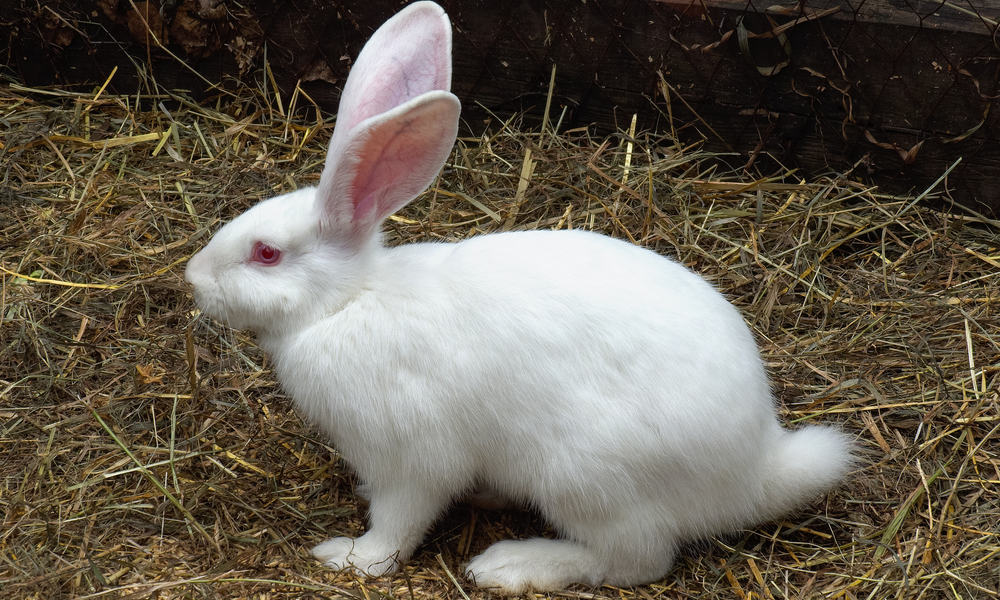On average, most domestic rabbit types have approximately 2 inches (5 cm) long tails, which is not as long as in most other mammals.
However, it typically contains 16 vertebrae (tail bones) supported by numerous nerves and muscles, making this body part highly mobile.
Still, many people are surprised when hearing that a rabbit’s tail is not short, soft, and round. The confusion arises because of its puffy ending that looks like a lovely cotton ball.
However, it is enough to gently pull your pet’s small ball tail to reveal its entire length.
Which Rabbit have the Longest Tail?
Larger breeds of rabbits, such as the Flemish Giant and Continental Giant, naturally have longer tails than smaller breeds. There’s no record of a Flemish giant’s tail length that we can find, but you can be sure it’s significantly longer than the examples given above.
The hare with the longest tail on record is a Continental Giant whose tail landed her in the Guinness Book of Records at almost 6.7 inches long. Continental Giants were originally bred for meat and fur, but have become coveted pets for many owners delighted by bigger bunnies.
Other large breeds bearing comparatively long tails are the Blanc de Bouscat breed, the Hungarian Giant, the British Giant, and the Giant Papillion. No matter the size, a rabbit’s tail is a vulnerable appendage that can be easily damaged or even torn off completely.
This can be a great advantage in the wild. For instance, if a predator snatches a rabbit by its tail, they can make an escape often without incurring more traumatic injury.
Rabbits can survive without their details, but domestic rabbits have a far better chance of not sustaining serious complications if their tails are accidentally removed.
The Purpose of Rabbit Tails
1. Protection
In most cases, domestic bunnies don’t have a white bottom tail part typical for wild rabbits because this kind of camouflage is not necessary for them to avoid predators. In fact, their tails are not crucial for survival, as is the case with those living in the wild.
2. Sign of emotional status
You can expect your bunny to keep the tail tucked inside the body most of the time since it is a natural position for this species. Interestingly, bunny’s tail posture can also show you its emotional state.
For instance, your fluffy friend will spend time chasing its tail when feeling bored or neglected. On the other hand, rabbits wag their tails to show disapproval.
If you notice that your bunny flicks its tail back and forth or rises it up while growling, you can be sure that it is probably angry. Such annoyed rabbits are often ready to fight to protect their territory.
A similar waving can be your pet’s way of showing how secure it is in your company. Be aware that it will never stretch its tail when cautious or you put it in a new or unknown space. The third possibility for such behavior is preparation for the mating season.
The best option is to see your buddy crawling forward with outstretched front paws while its back legs and tail are relaxed behind. It is a sure sign it is happy, curious, relaxed, and satisfied in your company.
3. Keeping balance
While the rabbit tail’s role is insignificant when this cute animal sits curled up, it is vital in helping it to keep its balance. Without a stretched tail resting against the ground, rabbits can’t stand up on their hind legs.
4. Signs of health issues
Believe it or not, your bunny’s tail can provide much information about its health. For instance, when your rabbit chews its tail, it is almost a sure sign that it suffers from fleas or parasites.
Do Bunny Tails Fall Off?
One of the common questions is whether a rabbit’s tail can grow up again after falling off. The disappointing news is that once your bunny loses its tail, it is an irreversible process. There is no way for it to grow back again.
The bright side is that fur grows over the place without a tail. In such a situation, your pet can continue to live normally, and the missing tail is not too noticeable.
Be aware that bunnies will never lose their tails without external influence. In some cases, a sharp object may cut it. Another option includes the possibility that another rabbit bites off your bunny’s tail while fighting. Finally, your pet can bite off its tail due to pain or too much pulling.
In any of these situations, it is crucial to call a vet immediately and let it treat a wound, stop bleeding, and prevent possible infection. After timely professional help, your pet will need a few weeks of rest to be fine.
Be careful and pay attention to protect the wound and disable your pet from biting its back side. It is also vital to tell your kids to avoid touching, tugging, or pulling a rabbit until the wound heals.
What are Rabbit’s Tails used for?
As we’ve just outlined, rabbit’s tails have a purpose. Notably, a rabbit’s tail exists to help it escape from predators.
The fur of the rabbit evolved to camouflage into their environment, while the small, contrasting tail serves to distract and confuse their pursuers.
Survival is not such a pressing concern for most domestic rabbits, but their tails are still a valuable asset. They help them keep their balance while in motion, for instance.
When a rabbit turns in one direction, its tail moves the opposite way, enabling them to spin even faster. Rabbit’s tails also developed to enable them to send subtle signals to other rabbits, namely their offspring and family members, to notify them of danger.
A rabbit who is feeling uncertain may stretch out its tail and angle it towards the ground. An angry rabbit, or one seeking to mate, may flick their tail back and forth.
A rabbit chewing its tail may be suffering from an infestation of fleas or parasites.






